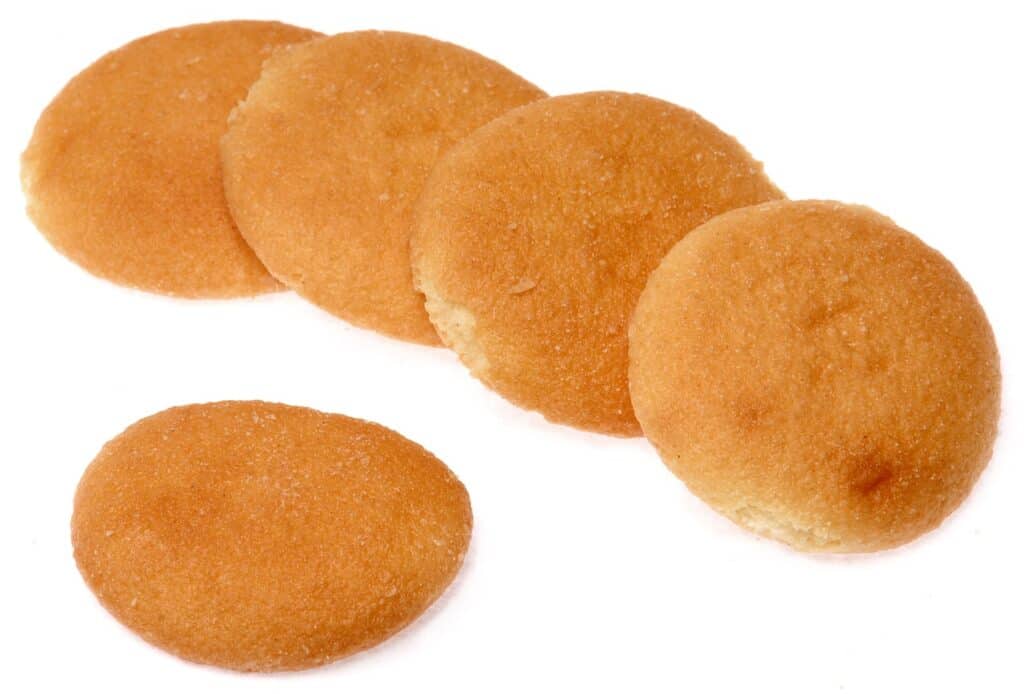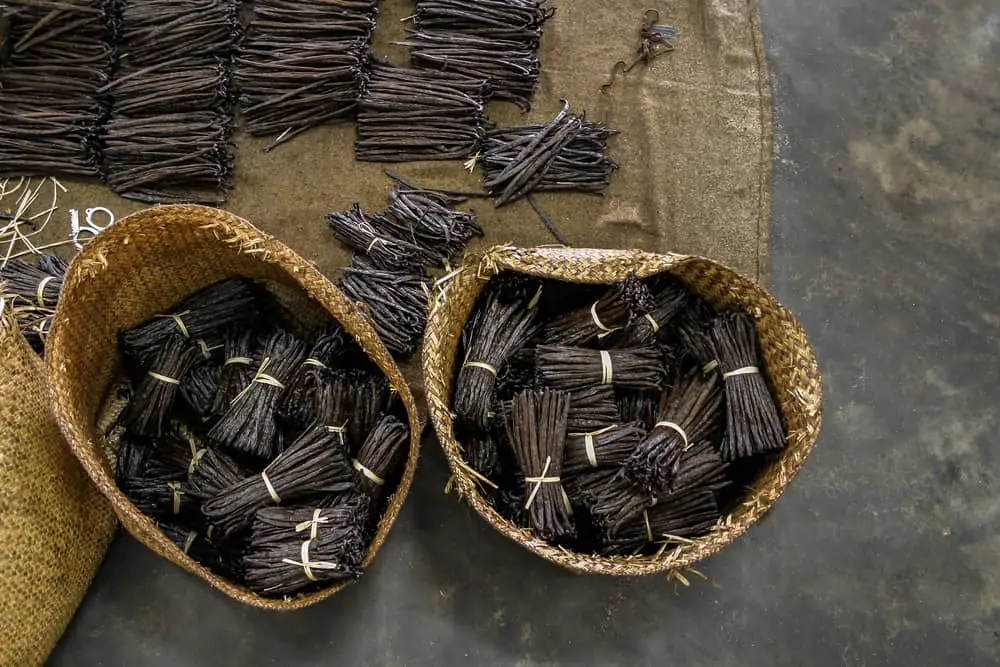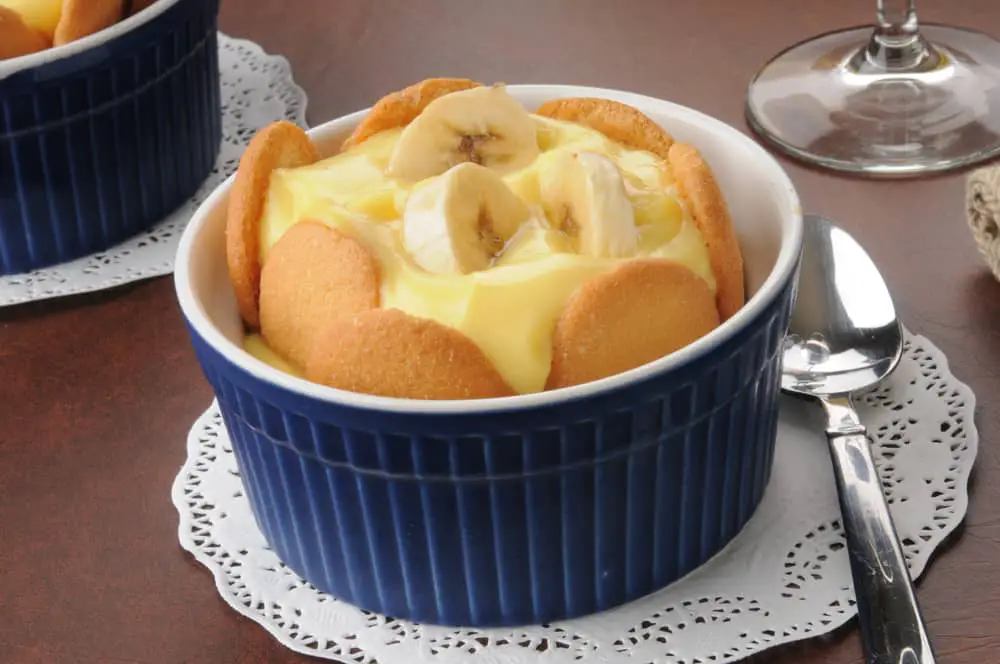“Nilla” is a brand name owned by Nabisco that is most closely associated with its line of vanilla-flavored, wafer-style cookies. The name is a shortened version of vanilla, the flavor profile common to all Nilla-branded products. Growing up, vanilla or nilla wafers depending on what these delicious treats were referred to in your household, were always a feature of many desserts. But what are Nilla Wafers and where did they come from?
Originally sold as Nabisco Vanilla Wafers, the product’s name was changed in 1967 to the abbreviated form Nilla Wafer. The original Nilla product is the Nilla wafer, a round, thin, light wafer cookie made with flour, sugar, shortening, and eggs.
Nilla wafers are for vanilla while the brownie and chocolate chip cookie is for chocolate. But even though these wafers are highly popular, these delicious, vanilla-flavored treats are sometimes overshadowed by their chocolate alternatives in the sweet world. In this guide, we will take an in-depth look at the history of the Nilla wafer. We will also explore how Nilla wafers are commonly used and what you can do with them.
What Are Nilla Wafers?

Nilla Wafers (Vanilla wafers) are crispy, light, vanilla-flavored cookies that melt in your mouth. And, they’re made with just a handful of ingredients you probably already have in your cupboards. The full recipe for this simple cookie uses only flour, sugar, butter, eggs, and vanilla extract.
It is a versatile cookie that can be enjoyed on its own or added to a banana pudding recipe, banana cream pie recipe, or a Boston cream pie recipe to add some light, sweet crunch.
Vanilla wafers have a rich and buttery flavor reminiscent of a shortbread cookie, butter cookie, or sugar cookie. In addition to being a key ingredient in a classic banana pudding, vanilla wafers can also be used in pie crusts and to garnish creamy desserts like ice cream and cheesecake.
History Of Nilla Wafers
Vanilla wafers had already become a beloved American cookie that you could purchase from the bakery by the middle of the 19th century. However, the recipe that you know and, presumably, love was devised by a man named Gustav A. Mayer, a confectioner from New York, who sold it to the National Biscuit Company soon after that company was formed via several mergers of smaller bakeries.
In fact, the National Biscuit Company’s very first use of the brand name “Nabisco,” the shortened version of “National Biscuit Company” that we know today, was in connection with selling the first Nilla wafers starting that same year.
Originally flavored with real vanilla, Nilla wafers have been primarily flavored with synthetic vanillin since at least 1994, a change that prompted some criticism. Presently, Nillas are described as having “natural and artificial flavor”, according to the ingredients list on the box.
Who Makes Nilla Wafers?
Nabisco began to produce the biscuits under the name Vanilla Wafers in 1898. By the 1940s, Vanilla Wafers had become a major ingredient in the Southern cuisine staple banana pudding, and Nabisco began printing a banana pudding recipe on the Vanilla Wafers box. The name of the product was not changed to “Nilla Wafers” until 1967.
Why Are Nilla Wafers So Good?
The texture is both crispy and aerated, and as they nestle into a bed of whipped cream or pudding, Nillas hydrate to create dissolve-in-your-mouth crumbs, not wet mush like other brands. It’s our platonic ideal of a vanilla wafer cookie.
What Do They Look Like?
Vanilla wafers are a type of disk-shaped buttery wafer cookie with a slightly chewy texture.
What Do Nilla Wafers Taste Like?
The primary taste of Nilla wafers is that of vanilla. But you can also expect to taste butter or shortening on the wafers as well. The texture is almost always crunchy, but personally, I prefer a softer style of Nilla wafer.
Are Nilla Wafers Cookies?
Sort of. Nilla wafers are just that–wafers. But calling these wafers cookies would not be too much of an incorrect assumption. Since Nilla wafers are round and sweet, referring to them as cookies is generally okay.
Are They Actually Made With Real Vanilla?

As common as vanilla may be as a flavor nowadays, there was once a point in history when it was a rare commodity, according to Scientific American. That’s because, at the time, things that were flavored “vanilla” had to be made with actual vanilla beans, or, at the very least, extract of vanilla beans.
Of course, that hasn’t been the case since the turn of the 20th century, which is when chemists invented “vanillin,” which can be manufactured without a lick of actual vanilla bean. Rather than vanillin can be “synthesized” variously from pine bark, clove oil, rice bran, and lignin. And since that time, of the roughly 18,000 metric tons of vanilla flavor produced annually, about 85% is vanillin synthesized from the petrochemical precursor guaiacol, with the rest from lignin.
Varieties
Nilla wafers come in many different types and flavors. Some of the most common types are:
- Chocolate Nilla Wafers
- Lemon Nilla Wafers
- Rainbow Nilla Wafers
- Strawberry Nilla Wafers
- Gluten-Free Nilla Wafers
- Mini Nilla Wafers
- Keto Nilla Wafers
- Low-Fat Nilla Wafers
- Pokemon Nilla Wafers
What Can You Make With Nilla Wafers?
Nillas are a common ingredient in banana pudding and are consequently very popular in the American South. In Atlanta and Houston, they are consistently among the five best-selling cookie brands.
Despite not being officially sold in the United Kingdom, shops that specialize in imported American brands may carry them due to their popularity with American expatriates and curious locals.
Nillas and their branding have also made their way into scientific studies. The wafers themselves are commonly used to facilitate the oral administration of various compounds or medications to rats in testing. Nilla’s branding has been used to study consumer preferences about variations in packaging.
How To Make Nilla Wafers
Vanilla wafers are almost just as simple to assemble as they are to buy pre-made. Most of the ingredients for vanilla wafers are probably already on your regular grocery store shopping list. However, there are a few rules of thumb you should follow to set yourself up for success when making vanilla wafers.
- Bring your eggs to room temperature. As you’re assembling your baking workstation, set your eggs on the counter and allow them to come to room temperature before you use them in your dough. Adding cold eggs to the wafer batter can potentially cause the mixture to curdle, preventing a smooth texture overall.
- Use high-quality vanilla. Due to the simplicity of this cookie, the quality of the vanilla you use in the recipe will make a major flavor difference. Opt for homemade or high-quality vanilla extract over a cheaper imitation option.
- Chill the batter. Chill your vanilla wafer cookie batter in the refrigerator for at least 15 before you start to form the cookies. This will encourage the wafers to maintain their shape.
- Store your wafers properly. Allow your homemade vanilla wafers to cool completely before storing them in an airtight container. Consume wafers that you store at room temperature within a week of baking them. Store the wafers in an airtight zip-top bag in the freezer for up to a month.
Substitutes
What you substitute for vanilla-flavored wafers depends on what you are using them for. For instance, if you are just using them as a cookie, any small butter or sugar cookie will work. But for a recipe, you can often substitute them with thin cookies or shortbread cookies.
Alternatively, if you are using them for a pie crust, use crushed Zwieback cookies, chocolate wafers, or graham crackers. Similarly, if you are making banana pudding, try using animal crackers, gingersnaps, shortbread, or chessmen butter cookies.
Nilla Wafers in Banana Pudding
While you can easily make banana pudding at home with pudding from a box, you can also make it completely from scratch with just a few additional steps. However, there are some key things you should know to ensure your pudding turns out the perfect creamy texture.
In a large bowl, combine pudding mix, milk, and sweetened condensed milk. Whisk until smooth. Place in the refrigerator for a few minutes to firm up.
In a large bowl of a stand mixer with the whisk attachment, whisk heavy cream and vanilla until stiff peaks form, about 3 minutes. Fold in half into the pudding mixture. Set aside the other half for assembling.
In a large trifle bowl or individual bowls, line your bowl with wafers. Spoon pudding mixture on top, then sliced bananas, then repeat until you are near to the top. Dollop your whipped cream on top. Garnish with more banana slices and/or vanilla wafers. Refrigerate for 2-3 hours or overnight. You can make this pudding mixture up to 3 days in advance and then assemble it the night before you want to eat it for the perfect soft Nilla wafers.
If you’re short on time, I’d say the minimum time you want to stick the pudding in the refrigerator is about 2-3 hours. I have used store-brand vanilla wafers and as far as taste goes, they’re great. The only downside to using off-brand is that there doesn’t seem to be as many in the box as the Nabisco Nilla Wafers. With the name brand, you’ll have plenty for topping.
I recommend making this dessert either the night before or a few to several hours before you’ll be serving it as you’ll want the cookies to have softened a bit.
To reduce calories, I used skim milk, fat-free Cool Whip, as this does not affect the taste at all but if you prefer the full calorie flavor, that’s certainly ok, too.

Nutrition
Nillas taste great right out of the box, but they don’t have much in the way of nutritional value. To make up for this, use them as the base of a snack made with more nutrient-rich ingredients. The beloved cookies are fairly low in fat and calories, but they do contain several grams of sugar per serving.
Are Nilla Wafers Healthy?
Nilla wafers are not anywhere near as unhealthy as some cookies and wafers. Sadly, however, their nutritional value lags. A snack that is more nutrient-rich is just as delicious as them when made with nutrient-rich ingredients. Despite its high fat and calorie content, Nillas from a variety of brands do contain some sugar per serving.
Despite the fact they’re unhealthy for you –although many of these wafers are just empty calories and sugar –these don’t provide enough nutrients to satisfy our receptors, including plenty of fiber, protein, and healthy fats. Although the magnetic pull of the cookie sleeve drags you back even after the first and second bites, and the fourth and sixth bites, you may forget about it.
How Many Calories In Nilla Wafers?
There are 140 calories in 8 Nillas. So, the calories count for one wafer is not that high.
How Many Carbs In Nilla Wafers?
Compared with other crystalline wafers, Vanilla Wafers (8 wafers) contain 18 grams of carbohydrates with 21 grams of net carbs, 5 grams of fat, and 0 grams of protein.
Are Nilla Wafers Vegan?
Both Nabisco Nilla Wafers and generic vanilla wafers are non-vegan. They contain milk derivatives, and generic versions of the cookie tend to contain egg and other non-vegan ingredients.
Are Nilla Wafers Gluten-Free?
Generally speaking, no, they are not gluten-free. Today, a few companies do make crispy-type gluten-free vanilla wafers. And they’re honestly not bad at all. But if you want the real taste you remember or just want to share that taste with someone who is gluten-free, make a dish with real Nillas and reduce the amount.
Are They Nut-Free?
Yes, Nilla wafers are nut-free. These wafers do not contain any nuts or nut derivatives in the preparation process.
Are Nilla Wafers Keto?
Not traditionally, no. But keto vanilla wafers are light, crispy, and as delicious as their high-carb counterparts. It’s a copycat recipe for vanilla wafers that will fool your taste buds and make you feel like you’re cheating on keto.
Made with only a handful of easy-to-source ingredients, these are homemade low-carb vanilla wafers that taste like the kind that comes in a Nabisco box.
Do Nilla Wafers Go Bad?
Nillas’ ingredients will not “go bad” in the first year of storage; however, the workability may change. After one year, candy wafers will usually have fat bloom, requiring them to be thinned out when melting. To eliminate such problems, purchase Nillas as you need them.
As a general rule, wafer paper lasts for 2-3 years when stored properly away from moisture. Manufacturers’ guidelines are generally 2 years, but that’s usually a “best by” date, not an expiration date.
If you want to keep Vanilla Wafers at room temperature, be sure to keep them in an air-tight container. They will last for up to five days.
Trivia
Since Nilla wafers are a popular snack, let’s take a look at some interesting Nilla trivia.
Can Dogs Eat Nilla Wafers?

No, dogs should not eat Vanilla wafers and especially not sugar Vanilla wafers. No matter how bad your dog may want to take a bite out of the Vanilla wafers you’re eating, you should not feed it to your pooch. Vanilla wafers are loaded with sugar, which could be detrimental to your dog’s health and cause dangerous health issues to your dog.
It’s always best to avoid feeding our furry friends sugary snacks like Nilla wafers or food that contains ingredients that are toxic to our pooch.
Can Cats Eat Nilla Wafers?
Shortbread cookies often contain unsalted butter, sugar, vanilla extract, flour, salts, and other components. Butter and vanilla are poisonous to cats, and too much sugar and salt can harm their health. Despite the fact that shortbread cookies contain less sugar than other varieties of cookies, cats are unable to consume them. Cats are completely omnivorous, which means they eat only animal-based foods.
As a result, giving your cat too much sugar, such as cookies, is not a smart idea. Shortbread cookies with chocolate chips, on the other hand, can be fatal to your cat. Even so, if your shortbread cookies don’t have chocolate chips, they’ll have a lot of margarine or butter in them.
As a result, pet nutritionists advise against giving this cookie to cats. Furthermore, because these cookies include a lot of butter and margarine, they are high in fat and might cause your cat to gain weight.
How Many Nilla Wafers Are In A Box?
A typical box of Nilla wafers can contain anywhere from as low as 12 mini-Nilla wafers to as high as 100 to 200 regular-sized Nilla wafers. It ultimately depends upon the size of the box you purchase.
Nilla Wafers Shortage
In the past few years, since at least the mid-2010s, there have been shortages of vanilla. This has indirectly led to shortages of Nillas sporadically during this time.
